
Expanding access to home- and community-based services is the recommendation from a new report from the Schwartz Center for Economic Policy Analysis on unmet care needs among the nation’s older adults.
Using data from the 2020 Health and Retirement Study, the policy note released Tuesday reported that nearly 20% of adults 55 and older — some 20 million people — had difficulty with one or more activities of daily living (ADLs) or instrumental activities of daily living (IADLs). Roughly 8.3 million of those individuals do not receive the help they need.
Only 23% of adults 55 and older who had difficulty with ADLs or IADLs receive care from a paid professional, including assisted living, home care or skilled nursing facility care. But the report noted that professional care is “prohibitively expensive” for many. The average cost of assisted living in 2016 ranged from about $3,600 to $6,800 monthly, depending on accommodations, while hourly rates of home-based care were roughly $20 per hour.
The nation’s long-term care system, the report authors noted, puts these individuals at greater risk of injuries and harm.
“Seniors who do not get the care they need are more prone to accidents and have more negative health outcomes, such as more emergency department visits and increased risk of mortality,” the report read. “Research shows that unmet long-term care needs of older adults are associated with higher disability levels.”
Stuck in the middle
The report also found that access to care is not entirely based on wealth. Significant shares of people in all wealth quartiles don’t receive the care they need. Lower-income adults qualify for public assistance through Medicare, Medicaid or other insurance, while wealthier adults can afford professional care — including private pay assisted living, home care or skilled nursing facility care — through private funds. That leaves the middle class most unable to access care.
Between 42% and 48% of people across all wealth quartiles do not receive any care despite having difficulties with ADLs or IADLs. The authors noted this lack of a wealth gradient was explained in part by different family structures and caregiving behavior across communities.
Many lower- and middle-income families, for example, provide unpaid family care to older loved ones, while higher income households either pay for professional care, reduce their work hours or quit their jobs to care for older loved ones.
“The gaps in care across the wealth distribution underscore the necessity of universal care for all elderly people,” according to the authors.
State variances complicate matters
The SCEPA report recommended expanding access to Community Medicaid to help older adults access the care they need while relieving the burden on unpaid family caregivers. Community Medicaid provides financial subsidies to Medicaid beneficiaries through two programs — home- and community-based services waivers, and Aged, Blind and Disabled Medicaid.
But the authors noted that access to these programs varies significantly across states. Even meeting eligibility requirements does not ensure access to Community Medicaid due to additional enrollment caps and years-long waiting lists in some states. Thirty-eight states have HCBS waiting lists, with a combined nearly 700,000 people waiting for services, according to a recent KFF analysis of state Medicaid HCBS programs.
Expanding access and raising enrollment caps in all states, but especially in states with long waiting lists or low-income and asset-eligibility caps, can help remove the disproportionate burden from family caregivers to ensure access to care for everyone, the authors concluded.


